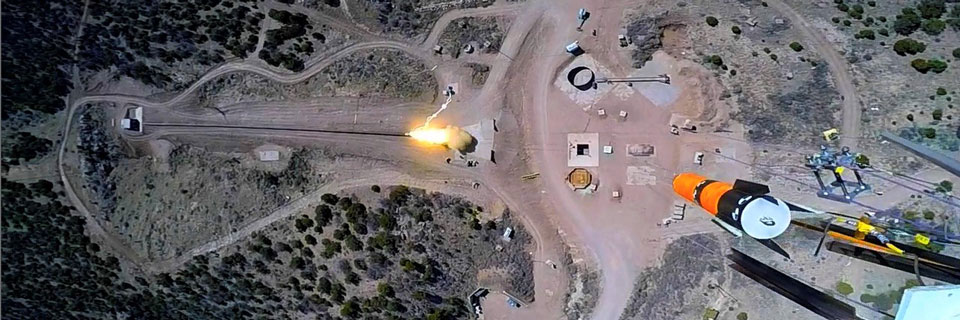
In FY17, Group 1530 test completed a rocket-assisted cable pull-down (CPD) test for the B61-11 program. This test was the end-point of over a year of hazardous test activities including static fire tests to characterize rocket motor thrust profiles, and a calibration CPD test. The surveillance test involved accelerating a high fidelity B61-11 test unit into a concrete target at a controlled impact velocity and angle. Data from internal instrumentation, photometrics, and post-test assessment of the test article provided key data to the surveillance program and to the annual assessment report. (1000, 2000, 600, 4000)
In FY17 the B61-12 and W88 ALT 370 programs successfully conducted key component reviews. The B61-12 program conducted 21 of 44 component Final Design Reviews (FDRs) in FY17 and has conducted 39 of 44 since 2016. The W88 ALT 370 program conducted 13 component FDRs in FY17 and has conducted 16 of 19 component FDRs since FY15. Also in 2017, the Mk21 program conducted five of eight component Baseline Design Reviews (BDRs) and the AFA BDR. Mk21 jointly participated in three of eight component FDRs with the W88 ALT 370 Program. (2000, 1000, 3000, 5000, 8000, 9000, 10000)
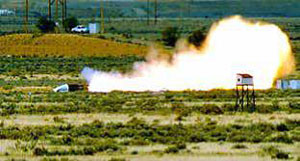
The B61-12 Nose Bomb Sub-Assembly (NBSA) team relies on computational simulation to successfully meet design requirements for ground impact (e.g., fuzing time, crush, and damage). Only five relevant tests were conducted, but the NBSA team simulated more than 2,000 impact scenarios spanning a range of impact speeds, angles, and orientations, using an estimated 13.2 million cpu hours. The NBSA model enabled evaluation of requirements over the full impact space. (1000)
MESA (Microsystems Engineering, Science, and Applications) delivered a record 26,000 microfabricated parts to DOE for the B61-12, W88-ALT-370, and Mk21 Fuze programs. Parts include Application Specific Integrated Circuits (ASICs) and Heterojunction Bipolar Transistors (HBTs). This is the largest ASIC production run in Sandia history and the first-ever HBT delivery from the MESA microfab. The high volume deliveries were enabled by a new Electronic Production Control System (EPCS) that reduced acceptance time by 80 percent, saved more than $18 million, and received a Defense Programs Award of Excellence. (2000, 5000, 8000, 9000)
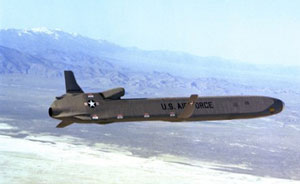
The W80-1 Alt 369 first production unit (FPU) was completed on Sept. 30, 2017, concluding a six-year development effort that met such challenges as redesigning components and gaining Pantex authorization. According to the National Nuclear Security Administration, this accomplishment is an important step toward maintaining nuclear capabilities that will help deter attacks on the United States and its allies. The W80-1, a warhead carried by the air-launched cruise missile, was first introduced to the stockpile in 1982. Alt 369 replaces limited-life components in the warhead. (8200, 2000)
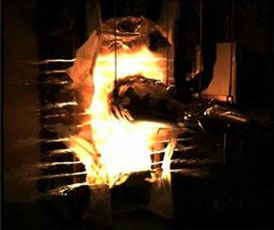
The Mk21 Fuze program made significant system testing progress in FY17. Data from the successful Light-Initiated High Explosive (LIHE) test series (May 2017) was used to validate system models and determine mechanical shock environments. In preparation for the first flight test, a ground test vehicle was assembled and environmentally tested at Sandia/California. The vehicle was then sent to Boeing and successfully tested in the integration testbed with Minuteman III missile system hardware in collaboration with Boeing, Lockheed Martin, BAE Systems, and the US Air Force. (8200, 2000, 1000)
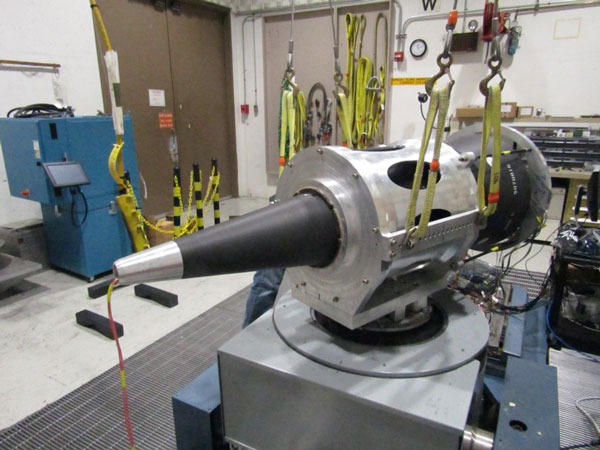
In September 2017, the W80-4 Life Extension Program team delivered Foundation Bus Development Kits to support integration with the Long-Range Stand Off (LRSO) cruise missile. This is the first hardware delivery to the US Air Force, which selected Raytheon and Lockheed Martin to competitively develop missile designs over the next four years. The development kits provide the LRSO program office and prime contractors with the necessary resources to develop, test, and verify the missile and warhead logical interface. The foundation bus is a Sandia-developed technology. (8200, 5000)
A team from Sandia’s DICE and STAR facilities and the nuclear weapons engineering, modeling, and simulation groups made key contributions to the scientific basis for certifying major weapon components and systems. The team instrumented sled track tests, supported the iterative design and validation of a key component, and characterized the crush response of an aluminum honeycomb material. The gun experiments provided cost-effective data to compliment large-scale testing. The new data acquisition techniques afforded a 10-fold improvement in timing resolution compared to previous diagnostics. (1000, 2000)
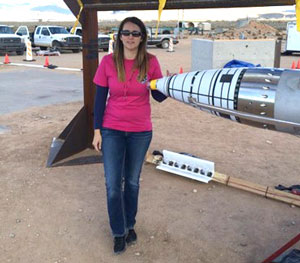
Partnering with Lawrence Livermore and Los Alamos national lab colleagues, about a dozen Sandians completed an 18-month project to inform the nation’s Nuclear Posture Review. This Tri-Labs effort resulted in 16 background papers succinctly describing pros and cons for nuclear weapons policy options. These well-received, highimpact, national-level decision-making products, delivered last year to Energy Secretary Rick Perry and Defense Secretary James Mattis, demonstrated Sandia’s ability to anticipate national needs and work at the intersection of technology and policy. (8000, 100, 1000, 2000, 5000, 6000)
Sandia and the Kansas City National Security Campus (KCNSC) have identified, researched, and selected a new conformal coating for the W88 Alt 370 program. A conformal coating is required in the application to provide environmental protection to the sensitive electronics. The new conformal coating replaces a previously selected coating that had demonstrated significant off-gassing of volatile species and poor accelerated-aging performance. The new coating does not suffer from poor aging behavior and exceeds requirements for the program. 1800, 2300, and KCNSC were the lead organizations.
The Program Office led a multidisciplinary team that evaluated nine different stockpile scenarios for the Nuclear Posture Review development. The analysis showed the ability of each site to deliver, what risks would be introduced, what assumptions would need to be made, how each site would be impacted, and how surveillance and dismantlement would be affected. The analysis and the results were compiled in three weeks to inform the discussions at HQ. The work used tools developed by the Enterprise Modeling and Analysis Consortium to quickly perform this task. (2100)
The Product Realization Information Management & Exchange (PRIME) project created an application that consolidated, modernized, and optimized the authorization (EA Web), storage and retrieval (Image Management System-IMS), and exchange (NSE Hub) of engineering authorizations (EAs) and product definition. It was successfully deployed in December 2016 across the NSE. PRIME has supported a significant increase in EA releases — from 792 per month in 2016 to 1,024 per month thus far, largely in support of product realization activities for the B61-12 and W88 ALT programs. (2000, 9000)
Tonopah Test Range successfully executed 100 percent of all assigned stockpile and developmental flight tests for the year, while integrating new sensor systems, data reduction software, and completing organic equipment upgrades to optical tracking systems, network and communication, and radar systems. Test planning, execution, and recovery processes and equipment were significantly adjusted to meet emerging requirements and mitigate associated hazards. (2000)
The Org. 2250 surveillance tester centrifuge team qualified the 50,000 g lb, Sandia-designed, high-onset QU2777 centrifuge with a new and redesigned centrifuge arm. The qualification marks the culmination of a multiyear effort to ensure the system is operating in a stable, reliable, and predictable manner. The centrifuge is used to simulate missile flight for system-level nuclear weapon surveillance testing at Sandia’s Weapons Evaluation Test Laboratory at the Pantex Plant in Amarillo, Texas. (2200)
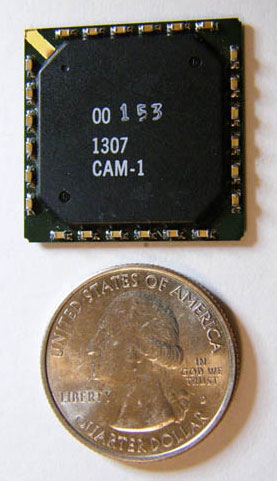
The design of the Common Authentication Module (CAM) Application Specific Integrated Circuit (ASIC) has been completed and production has commenced with the delivery in October 2017 of 96 diamond stamped parts. The CAM ASIC is a secure processing platform meeting strict National Security Agency security requirements for Nuclear Command and Control and similar high consequence applications and is fabricated using Sandia’s 350nm CMOS7 rad-hard process. (2000, 5000, 8000)
Sandia provided all its deliverables in support of the Department of Energy’s National Nuclear Security Administration (DOE/NNSA) officially authorizing the Production Engineering Phase (Phase 6.4) for the W88 Alteration (ALT) 370 program on Feb. 22, 2017. This milestone represents the culmination of four years of work in the Development Engineering Phase (Phase 6.3) of the program, and marks the beginning of the Production Engineering Phase prior to production. The first production unit (FPU) of this weapon is planned for December 2019. (2000, 1000, 3000, 5000, 8000, 10000)
Sandia successfully executed end-to-end performance functional demonstration of the ISA-SCR (Integrated Surety Architecture-SGT Compatibility Retrofit) components and ALT 940 electronics in the Sandia Test Vehicle. This represents an important integration milestone between the ISA hardware and the transportation venue critical to successful project execution.
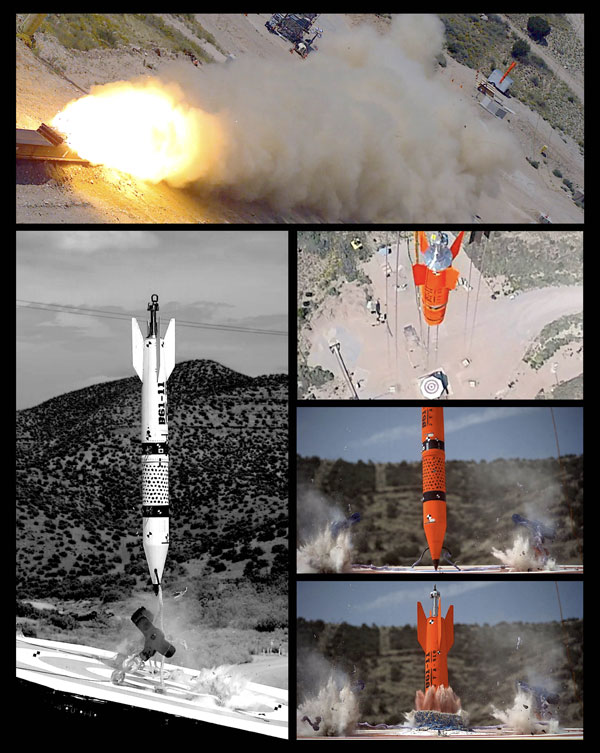
A B61-11 Cable Pulldown Surveillance Test was conducted at the Sandia Aerial Cable Facility on Sept. 7, 2017. This test imparted worst-case temperature and impact environments not achievable through flight testing. This significant accomplishment demonstrated a cross-cutting team’s readiness to execute a complex surveillance test that occurs infrequently, as well as an integrated process and ability to successfully manage significant hazards for safe acquisition of high-value data. (2000, 1000, 4000, 6000, 0600, LANL, KAFB Firefighters)
The W88 ALT 370 program completed its first fully functional flight test in FY17. This was the fifth flight test performed as part of the W88-0/Mk5 ALT 370 qualification program. The two flight bodies demonstrated end-to-end functional performance of the development joint test assembly, and collected critical functional data to verify requirements. The successful flight was accomplished by a multi-disciplinary team from Sandia’s California and New Mexico sites as well as external partners. (2000, 1000, 5000, 8000, 9000)
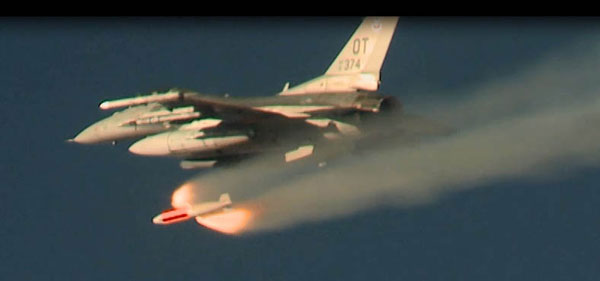
This year marked the beginning of the 24-flight, three-year duration, qualification flight test program for the B61-12. Since March 2017, the B61-12 flight test team, in partnership with Sandia’s Tonopah Test Range and the Air Force 422nd Test and Evaluation Squadron, have successfully planned and executed five development flight tests. The tests were flown on F-16C and F-15E aircraft originating from Nellis Air Force Base, and exercised both ballistic and guided trajectories with a variety of arming, fuzing, and firing settings. (2000, 600, 1000)
Dramatic reductions in size and weight are the result of continuous improvement in Electronic Neutron Generator (ELNG) design. From the first ELNGs incorporated in the B83 and B61, significant reductions in volume and weight were realized for use in the B61-12 LEP. Development hardware demonstrated for the W80-4 is nearly half the size and weight of the original legacy ELNG designs. (2500, 1500, 1800, 2100, 2200, 5200, 8200)
Magnesium oxide (MgO) is a critical material for powering the Nuclear Deterrent (ND) Mission. For the first time, the MgO team has developed the fundamental science- based understanding of the material structure-function relationships for ion transport and have captured the critical parameters needed to replicate its performance. While this work is of primary interest to our ND capabilities, it also impacts the defense community. Significant contributions to this work were made by 1000 and 2000.
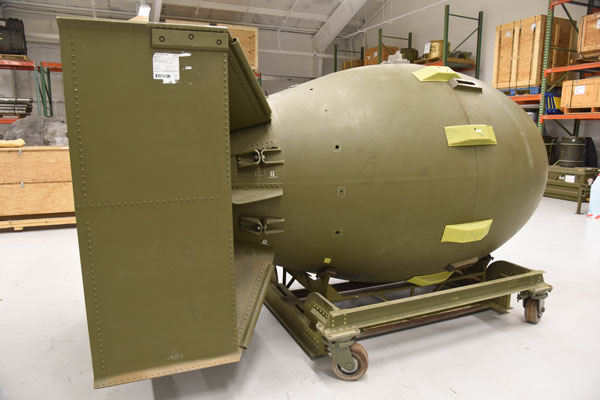
The Nuclear Weapon Legacy Hardware Laboratory Team received an NNSA DP Award of Excellence for successfully creating and implementing robust processes for the characterization and disposition of legacy nuclear weapon hardware, while enhancing the preservation of historically significant nuclear weapon systems and hardware knowledge. This work provides the foundation for nuclear weapon engineering education and studies in safety, surety, emergency response, and intelligence analysis and nonproliferation research. (2000, 10000)
The Neutron Generator Enterprise (NGE) met or exceeded all deliverable commitments in the FY17 NGE Integrated Program Plan. This included a significant number of NG builds representing nine NG products in development and production. There were more than 45 unique continuous improvement activities worked within the NGE focused on production operations in FY17, including fixture and inspection enhancements, increased data analytics capabilities, equipment modernization, and optimization and standardization of processes. (2500, 9400, 1500, 2100, 2300, 8200)
Sandia External Production (SEP) delivered thousands of parts for multiple weapon systems, in support of the stockpile, with a budget of more than $225 million. SEP production efforts focus on a challenging mix of hardware products not produced elsewhere within the Nuclear Security Enterprise. External supplier partnerships exist for products with highly integrated technical production challenges. Hardware is produced internally when vendor base cannot support production. SEP provides program and supply chain management to ensure requirements and expectations for nuclear weapon production deliverables are met. (2000, 5000, 10000)
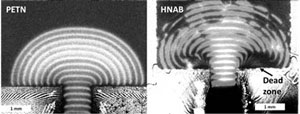
What happens when a detonation hits a corner? Modelers/ designers need to understand to optimize explosive performance. Techniques to see “inside” explosives during detonation, like flash X-ray, have limited resolution. Researchers in 02554 developed techniques to deposit and detonate thin-films of explosives to study performance at small scales. Using conventional ultra-high-speed imaging, the first optical images of corner turning behavior were presented at the 2017 American Physical Society Shock Meeting in the paper “Detonation Corner Turning in Vapor-Deposited Explosives Using the Micromushroom Test.” (2000, 1000, LDRD)
For eight surety mechanism major components, comprising several hundred custom mechanical parts, the following milestones have been completed: five Final Design Reviews, one Baseline Design Review, 12 Production Readiness Reviews, four top level Complete Engineering Releases, and numerous sub-assembly and production tester Qualification Evaluation Releases. First Production Unit is less than one year away for most of these components supporting B61-12, W88 ALT 370, and Mk21 Fuze, and development hardware has been flown successfully in all flight tests. (2600, 2300, 2200, 1800, 1500, 9400)
Organization 2630 has successfully completed all component Final Design Reviews for custom connectors, capacitors, cables, and magnetic components for the B61-12 and W88 Alt 370 programs, with many having completed Process Prove-In and several having been qualified. This represents almost 200 component designs. In addition, the COTS department has released life of program buy engineering releases for more than 1,000 parts, with roughly 500 having received their final qualification. This effort represents a tremendous accomplishment in partnership with our production agency, the Kansas City National Security Campus.
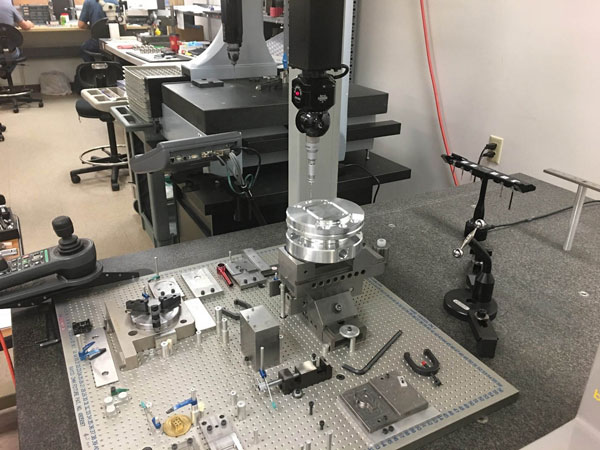
Division 2000 is exploring model-based processes and tools used throughout the product lifecycle to increase cycles of learning and quality and decrease interpretation errors by collaborating with the Kansas City National Security Campus and NNSA on the Model Authorized Product Realization (MAP-R) project. The MAP-R project is comparing the same product using a conventional 2D drawing-based process and a 3D model-based process and answering questions about the business benefits of model-based definition, how to manufacture and inspect based on a model, and what capabilities are needed for the future. (2000, KCNSC, NNSA)
A large remote sensing ground system called FROGS was successfully transitioned into an operational capacity in October 2017. This marks the near completion of a 4.5-year enterprise project to upgrade hardware and software, add new mission capabilities, and improve operator workflow. The new ground station is exemplary in design and function for the nation. As significant contributors to the Advanced Systems Program Office, Data Systems Engineering (2660) staff and management are proud of our contributions to the design, integration, deployment, and operations of this milestone.
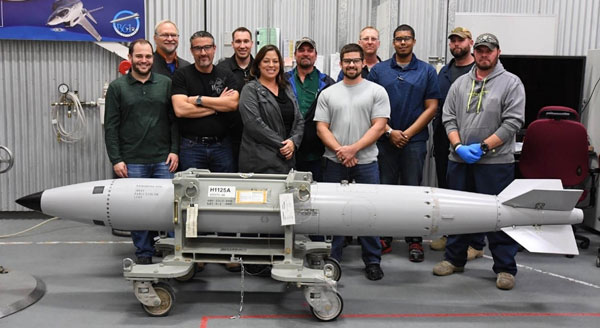
The B61-12 program has successfully executed a series of monthly system-level assembly builds of trainer hardware to support process development, tooling trials, and definition maturation for production transition. Using an early Type-5B trainer, Sandia, in coordination with Los Alamos National Laboratory and CNS Pantex, have successfully demonstrated the ability to safely and securely produce the B61-12 ultimate user configuration. Requirements, tooling, and processes were developed to ensure principles such as nuclear safety, assurance, and use control are at the forefront of the production strategy. (2000)